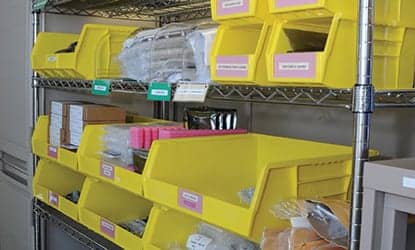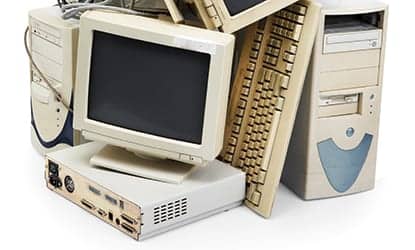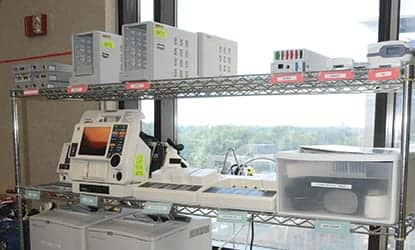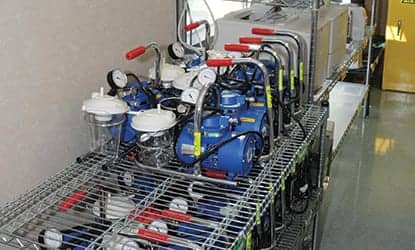
Emphasizing cleanliness and organization, Lean tools can empower biomeds to design best practices that eliminate waste and improve workflow
By Todd Hazzard, CBET
Have you ever been called a hoarder? Are health care technology managers inherently hoarders? Those who are compulsive hoarders or pathological collectors engage in excessive acquisition. They also cannot dispose of large numbers of objects that most people would view as useless. Hoarders collect because they feel that they may need a particular item one day. The problem is, they typically do not know what they have or its location. While these types of hoarders are the extreme examples and are not in your typical biomedical department, we may, however, share some traits. Typically, we do hold onto items because we might need them one day.
Ask yourself the following questions:
- Do you have a secret stash of parts, tools, or service manuals that others must come to you for in order to borrow?
- Do you have parts in your department for a piece of equipment that the hospital no longer owns?
- Do you have paper or electronic service/owner’s manuals of equipment that has been retired?
- Do you have test equipment and/or test fixtures that are supposed to be shared but are kept in your toolbox, cart, or workbench?
If you answered yes to any of these questions, you may be considered a hoarder. Ask yourself why. Is it because you are too busy to look for shared items? Is it because one time when you went to get a part you found a colleague used the last one and did not replace it? Was the item retired, but no process existed to remove the service manual or parts? Deep down, do you enjoy the fact that you have become the resident expert on servicing a particular device? Do you want others to come to you for parts, service manuals, or knowledge?

These are all valid reasons for this behavior, but these actions can have a negative impact on you, your team, and the department’s efficiency. When we have too much inventory of an item, or inventory that is not organized, or inventory in multiple locations, we have waste. Have you witnessed two of your co-workers arguing over who used the last part or who did not return a tool or piece of test equipment? If we were to ask why five times to get to an actionable root cause, we would, most likely, come up with trust issues. When a team or team member has trust issues, it can erode the functionality of the team and create waste due to redundancy.
Let me introduce you to Lean Thinking, particularly Six S (6S).At McLeod, we use 6S, but you may have also heard this referenced as 5S. At McLeod, 6S stands for sort, scrub, set, standardize, sustain, and safety. Lean is about continual improvement, and it is customer focused. Lean empowers the people who do the work to design best practices. It eliminates waste and creates flow. Continual improvment is about always looking for waste and never being satisfied with waste. Lean is about understanding that waste compromises the efficiency of your team, and living with waste is disrespectful to your team members. Customer focused means that every decision is viewed from the end customer’s perspective. Does this add value or add waste for the customer? Everyone focusing on the customer is the start of a team moving in the same direction. Lean understands that the people actually doing the work know best how to remove the waste and create the best flow. These are the basic principles of Lean Thinking.
You will be surprised by what this change in your work environment can do for your team. |
Studies have shown that people spend half their time at work looking for things. Often we do not even notice the waste. We get used to things being a certain way, and we never see the waste right in front of our eyes. 6S helps to eliminate that waste and allows people to work smarter, not harder.
6S can be used as a preliminary step toward process improvement and as the first step in implementing Lean principles. Once 6S is implemented, standardized work practices can be developed. In-process quality can be “built in” and not “inspected in.” Because workplace organization and orderliness are intuitively beneficial, it is helpful in getting employees to buy into other improvement efforts.
Step 1) Sort
- Get rid of clutter. Remove things not needed.
- Inventory everything.
- Keep only what is necessary.
- Move materials, tools, equipment, and supplies not commonly used to a separate common storage area.
- Discard items that are not used.
- Once all unnecessary items have been removed, you can see the true space available.
- Often, you will notice a 20% to 50% increase in floor/office space.
- In some cases, expansion plans have been put on hold because the sort process has shown a dramatic increase in available space.
- If sorting is not done, moving equipment, creating new layouts, creating workflow, and creating standardized work practices will result in less than desired results.
Step 2) Scrub
- Clean the work area and equipment. Once unneeded items have been removed, it is necessary to clean the work area.
- Lack of time is the excuse most often given for peoples’ work areas not being maintained in a scrubbed state.
- When a work area is kept in a scrubbed state, abnormal conditions are easier to spot.
- A work area kept scrubbed presents an image of high quality.
- A clean work area improves employee pride and morale.
- Take time to keep work areas in a
- scrubbed state every day. Each person understands their role in keeping their areas clean.
- Step 3) Set to Flow
- Organize the work area of Flow, which relates to the movement of people, materials, and work.
- Create a place for everything, and put everything in its place.
- Once necessary items are in a workplace, organizing what remains to create the most optimum and effective workplace layout becomes easier.
- Arrange things around workflow.
- Place supplies at point of use.

Step 4) Standardize
- Use standard methods to keep sort, set to flow, and scrub to a functional condition.
- Without standardizing, the benefits and gains attained in the first three steps will be eroded over time, and processes will most likely revert back to the old way.
- In this step, develop standard work procedures/practices that will serve to train new employees in 6S as well as ensure that current employees continue to maintain the 6S ways.
- It is critical that managers and supervisors constantly reinforce the standard practices and take immediate corrective action when nonconformance to standard practices are observed. Manage standard work.
- Be alert to resistance to change.
- It takes a person doing something 21 times before it becomes a habit.
Step 5) Sustain
- Maintain processes through empowerment, commitment, and discipline.
- Practice good work habits.
- Work according to the 6S principles without deviation.
- Utilize problem-solving to resolve day-to-day 6S problems.
- Communicate the success of the 6S program throughout the organization.
Step 6) Safety
- Prevent accidents and injuries while enhancing awareness.
- Safety is priority number one.
- Safety and quality go hand-in-hand.
- Safety improves as the previous 6S steps are established.
Getting Prepared
There is preparation work that will help you become successful in 6S.
- Choose your scope.
- Do not go too big on your first 6S event. You need a win.
- Choose a common area that can be emptied, cleaned, labeled, and set back to order within 8 hours.
- Understand the space and the current flow. You can do this by getting a drawing of the area and listing out all of the tasks that are done in this area.
- Pick a date, and make sure that all impacted parties are aware of what you are doing.
- Contact environmental services, plant operations, and other service departments.
- Some items that you will want to have on hand for the event are a camera, labeling devices, lamination devices, and automotive pin striping tape, etc.
- You will want to score your “as is” state before starting the event and take plenty of pictures.
You will be surprised by what this change in your work environment can do for your team. The process of going through a 6S event will be trying. Force your team to work together, and in the end you will begin to build trust. One 6S event will not solve all your problems. Remember this is a continual improvement process, and it will take several events in that one location before you can sustain your gains. The environment changes are typically easy to correct; it is the people changes or removing those trust issues that are more difficult to sustain. For those of you who chose to implement a 6S event, I wish you success.
I want to thank my team and my sensei for joining me on this journey. I use sensei as a respectful term to identify those valuable teachers/mentors in the McLeod operational effectiveness team: Will McLeod, Renee Kennedy, Larry Adams, Thomas Hunter, and Diane Osterman. Special thanks to the biomed department: Edwin Baroody, CBET; Brent Shedd; Chuck Cook, CBET; Denise Ferber; Jay Morgan, CBET; Jim Bickel; Jim Grimison; Joe Cook; Josh Griffith; Justin Miller; Kurtis Taylor; Robert Fuller, CBET; Roger Moore, CBET, CRES; Jennifer Bennett; Jordan Hunter; and Debby Mays. 24×7, November 2012
Todd Hazzard, CBET, is the director of biomedical services, McLeod Health, Florence, SC. If you have any questions or would like to share your experiences with 6S, contact the editor via e-mail.




